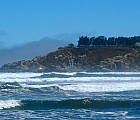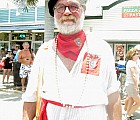
Hemingway On Stage: An Interview With Brian Gordon Sinclair
August 15, 2018
A Portrait of Hemingway as a Young Man: An interview with Writer and Satirist Jerome Tuccille
August 15, 2018An Interview with travel writer David Lansing: following the Hemingway trail


AB: At what age did you get interested in Hemingway? Was it a particular book that sparked your interest or was it Hemingway himself?
DL: I think the first Hemingway book I read was The Sun Also Rises. I must have been about 14. This was around 1967. I didn’t know anything about the book and all I knew about Hemingway was that he had shot himself in Ketchum a few years earlier (my grandmother, for some odd reason, had kept the Life magazine story that covered his funeral and I remember being oddly affected by a photo of the funeral party at the Ketchum cemetery, perhaps because the shot was obviously taken at a great distance and so you sensed the cold and bleakness and a certain melancholy infusing the photo). Anyway, I read The Sun Also Rises during the summer while in junior high school and what I remember is being totally swept up in the austere romance of it, the way it transported me emotionally. I probably read the book in one sitting and then went back and got everything else I could get my hands on that he’d written and then I started reading other writers associated with him–Fitzgerald, Dos Passos, Stein. But it was Hemingway that really did it for me. It became my literary watermark, the point in my life when I went from reading adolescent literature like Robinson Crusoe and Hardy Boy mysteries to these books that both excited and disturbed me intellectually.
AB: You are a self proclaimed “Closet Hemingway freak”. Aside from your travels, how does this manifest in your life?
AB: Have you met others on “the Hemingway trail”? How do you explain the compulsion to follow it, as so many do!? Do you have any quirky interesting stories about those you’ve met on the Hemingway Trail?
AB: You mention in your article that Hemingway has been out of fashion, especially for women, in the last 50 years. What attitudes about Hemingway have you encountered in your travels? Do they differ from France to Spain or Cuba to Key West? What are the differences?
BL: Well, I don’t think any country reveres Hemingway more than Cuba. Partially because Castro has turned him into a tourist industry but also because Hemingway truly loved the Cuban people. For them, when he said after receiving the Nobel Prize in 1954 that, “This prize belongs to Cuba, since my words were created and conceived in Cuba, with the inhabitants of Cojimar, of which I am a citizen”…well, it was almost as good as if a Cuban writer had received the Nobel. And their love for him was heartfelt and still is. The majority of people who go through Finca La Vigia are Cuban. And going on a field trip there for Cuban students is a regular part of their curriculum. Personally, I love to go down to Cojimar, the little fishing village that became the setting for The Old Man and the Sea, and watch the Cubans come to pay their respects at the bust of him that was erected by the fishermen here the year after this death. These were very, very poor people (and still are) and the only way they could pay for this bust was by collecting old propellers and other bits and pieces of bronze and melting it down. And then you sit there by the seawall and you watch some Cuban father bring his young son here and have him touch Papa’s worn head and you realize that they consider him to be almost a saint. (FYI, the photo I’ve attached is of me beside the Hemingway bust at Cojimar.)
AB: If you could meet Hemingway, at what point in his life would you have liked to know him?
DL: Definitely when he was married to Hadley and they lived in Paris in the 20s–before he became a little bit too full of himself. I think he was still forming and hadn’t yet solidified into the Hemingway character and was probably more interesting because of it.
AB: Where was your favorite Hemingway trip? I know this is a tough question! If you can’t narrow it down, can you tell me about some of your favorite moment in Hemingway travel?
DL: Nothing is more evocative than Finca La Vigia. To see the pencil marks on the bathroom wall where he recorded his daily weight or the pool where he swam his laps (and went skinnydipping with Ava Gardner) is to feel his presence in a way that you don’t get walking around the streets of Pamplona or Key West. I also remember slowly drinking a beer on the terrace of the Closerie des Lilas where Hemingway let James Joyce buy him lunch on occasion and where Hemingway himself often times ordered a single beer and slowly drank it while working on The Sun Also Rises. That was a very evocative experience for a 22-year-old boy (me) who had just moved to Paris to write and to live.
AB: Okay, so you really lived in the left bank of Paris in a dingy apartment, drinking cold wine, etc. . . did that fulfill something for you, and what was it?
DL: Well, doing the whole Hemingway thing in Paris when you are 22 is both wonderful and deadly. Wonderful because you find yourself walking in the footsteps of people like Hemingway and Fitzgerald but also deadly because it is very hard to get them out of your head when you are writing. I kept a blue notebook at the time, which I still have, and it is filled with some of the most awful faux-Hemingway writing you can imagine, stuff so bad that on occasion I’ve been tempted to submit it, as is, to the Bad Hemingway contest. The problem is that I didn’t mean for it to intentionally be silly. It just was.
DL: There are many articles about Hemingway’s house in Cuba claiming that it’s haunted. Did you talk with anyone in Cuba about that?
His spirit is definitely there but I wouldn’t call the house haunted. The guides like to tell stories about the radio turning itself on or the booze bottles next to his favorite easy chair suddenly appearing on his writing desk, but I think they’re just drumming up interest.
AB: If you could ask Hemingway anything, what would you ask?
DL: I don’t have any pressing questions. If he somehow showed up at a dinner party and was seated next to me, I might ask him who he regretted not sleeping with (and if he really had an affair with Ava Gardner). I don’t think I’d ask him anything about his work because I know he was a firm believer that the work needed to stand on its own and authors shouldn’t go around explaining it. I think that’s wise.
AB: I’m sure you’ve been in Hemingway museums – what is your favorite Hemingway artifact?
DL: There are several of them, actually. They rotate the display items in and out of his room at the Hotel Ambos Mundos in Havana, which has been turned into a one-room museum and where he wrote much of For Whom the Bell Tolls, but the first year I was there they had his cancelled passport from 1957, and the curator, knowing I was truly a big Hemingway fan, locked the room door when I was the only one in there and opened up the glass case and let me hold the passport. That was very cool and I’ve never seen the passport displayed since. And then in his room in Finca Vigia there’s a small, hand-carved cigar case and on the inside lid is inscribed “Ernest Hemingway/ Gran Amico de Cuba” It’s signed “Jaime Bofill.” I’ve Googled Jaime Bofill and come up blank and even the guides don’t know who he is so it’s a bit of a mystery and I’ve always been curious about what the circumstances were in regards to this gift.
AB: What’s your favorite Hem book? Did it change after you visited so many of the setting EH used?
DL: I still love the first book of Hemingway I ever read, The Sun Also Rises, and think it has held up really well. Over the years I have taught travel writing classes and usually the first thing I have my students read is The Sun Also Rises because I think it’s the greatest travel story ever written. It does what any really good travel story does and that is to give you a very strong sense of place and make you want to go there. And considering how many millions of people have gone to Pamplona since that book was first published, I’d say Hemingway was extremely successful, even though he wasn’t writing a travel story. The first time I went to Pamplona I think I was 26 or 27 years old and I hated it. In a way, I wished I hadn’t gone because I had an image of it in my head that was very different from the way the real Pamplona was 50 or so years later and after that, I could never read those scenes without having them marred by the real-life images. Harry’s Bar in Venice is a bit like that as well.
AB: I think Hemingway represents a lot of different things to different people – a particular way to be a man, the courage to be an artist, the freedom to live an expat life –what is it about him that most speaks to you?
DL: I think a lot of the Hemingway macho stuff was a bunch of crock and he started believing too many of his own press clippings. When I was younger, I adopted his “courage is grace under pressure” motto as my own, but as I’ve gotten older, I think that even for Hemingway it was a facade. In a way, Hemingway became a “character” much the way Elvis or Jim Morrison became “characters” and it was part of his demise both as a writer and as a person. There was an authenticity in something like The Old Man and the Sea that just wasn’t there in Islands in the Stream where you felt he was writing about a Hemingway character who was bold and courageous and loved nothing more than to be out on the water with other good men. But I think what I’ve always admired about Hemingway, and still do, is the honesty and the leanness in his early writing. There is a connection with what he was doing and what Dreiser or Dos Passos were doing, but to me, the advent of modern writing really began with Hemingway. He taught so many writers how to write simple sentences that were really very complex and how to leave things out of your writing as a way to make it stronger–the whole iceberg thing of writing where you say almost as much about something by what you leave out as by what you include. It looks easy when you read it but it’s very, very difficult to do, and that’s what continues to speak to me as a writer.
February 17th, 2010
Filed under: Hemingway Trail , Interview – David Lansing
Post tags: David lansing • Hemingway Trail • Travel writing


